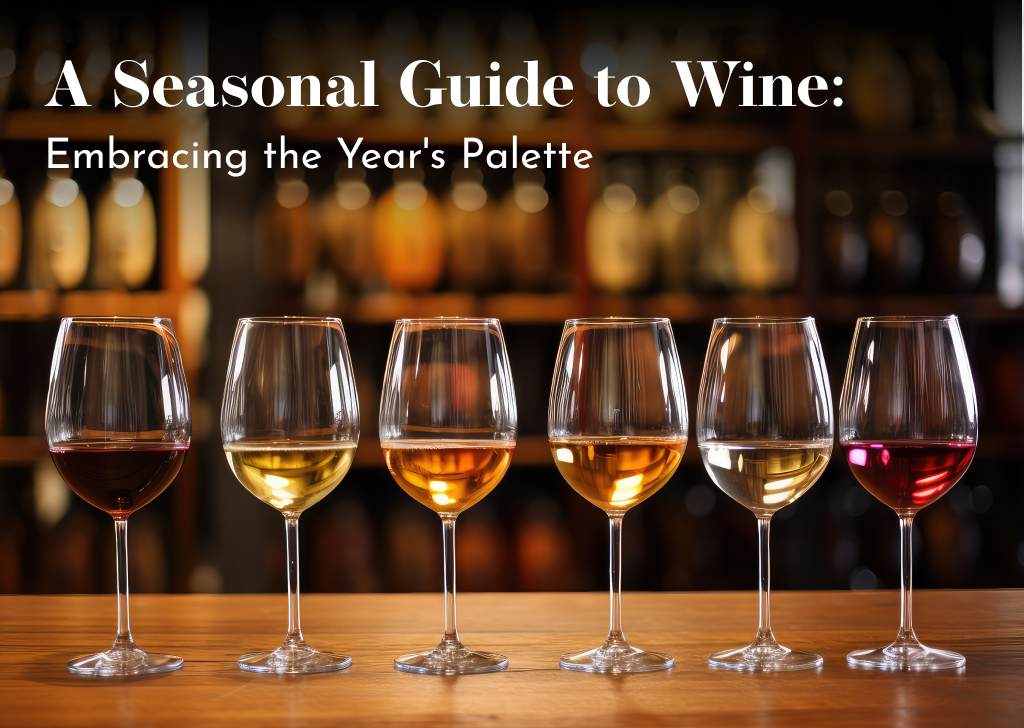As each season unfolds, it brings with it a shift in our wine preferences, subtly influenced by the weather, seasonal foods, and the activities we enjoy. This guide explores how these changes affect our wine choices, offering insights for connoisseurs and casual drinkers.
Spring: The Season of Light and Crisp Wines
With the arrival of spring, there’s a noticeable shift towards lighter, more refreshing wines. This is the time to put away the heavy reds of winter and embrace the crisp acidity and vibrant fruit flavors that echo the season’s freshness.
Sauvignon Blanc and Pinot Grigio stand out during these months thanks to their bright acidity and lively fruit notes, which pair wonderfully with spring vegetables and lighter dishes. These wines capture the essence of spring’s renewal, offering a palate-cleansing freshness that’s much needed after winter’s richness.
Rosés also begin to make their mark in spring, bridging the gap between the robust wines of winter and the lighter selections of summer. Their versatility and range of styles—from dry and minerally to fruity and floral—make rosés a favorite for springtime picnics and gatherings.
Summer: A Time for Refreshing Whites and Rosés
As temperatures climb, the preference leans heavily towards wines that offer refreshment. Summer is all about staying cool, and the wines we choose play a significant role in this seasonal ritual.
Chardonnay, especially in its unoaked form, has become a popular choice. Its ability to be served well chilled without losing character makes it ideal for hot summer days. Albariño, with its zesty acidity and citrus flavors, offers a crisp, refreshing option that pairs excellently with seafood, a typical summer food.
The popularity of rosés continues into the summer, with their light body and cooling effect, making them perfect for outdoor dining and barbecues. Additionally, sparkling wines, including Prosecco and Champagne, are favored for their festive feel and refreshing bubbles, suitable for summer celebrations.
Autumn: Medium-Bodied Reds and Rich Whites
As the air cools and leaves begin to turn, wine preferences shift towards medium-bodied reds and richer white wines. This change is influenced by the season’s heartier dishes and the instinctive turn towards warmth as the temperatures drop.
Merlot and Pinot Noir become the reds of choice, balancing the light wines of summer and the heavy hitters reserved for winter. Their moderate tannins and fuller flavors, from squash to mushrooms, pair well with the season’s harvest.
For white wines, oaked Chardonnay comes into play, offering a creamier texture and richer flavors that complement autumn’s comfort foods. Its versatility makes it a staple for those looking to transition smoothly from summer to winter.
Winter: Bold Reds and Fortified Wines
Winter calls for wines that provide warmth and comfort during the colder months. This is when bold, full-bodied reds and sweet, fortified wines take center stage.
Cabernet Sauvignon, Syrah, and Zinfandel are popular choices, known for their deep flavors and higher alcohol content, which provide a warming sensation. These wines pair excellently with hearty winter dishes, such as stews and roasts, making them a go-to for holiday meals and gatherings.
Port and Sherry also see increased consumption during winter. Their sweetness and complexity offer a comforting end to a meal or a cozy night in. These fortified wines can also serve as a base for warm, spiced wine drinks, a winter favorite in many cultures.
Biodynamic Winemaking and the Calendar
In addition to the seasonal shifts in wine preferences, there’s a fascinating trend in the wine industry known as “biodynamic winemaking” that harmonizes vineyard practices with the lunar calendar. Advocates believe that planting, pruning, and harvesting according to the moon’s phases can enhance the quality and character of the wine.
This approach, which also emphasizes organic farming methods and a holistic view of the vineyard as a living system, has gained traction among producers and consumers alike for its sustainability and the perceived depth it adds to the wine’s flavor profile. This ancient practice, revived for modern palates, adds an intriguing layer to the seasonal wine experience, suggesting that the best bottle might not just be about the time of year, but also the moon’s cycle.
Adapting to Seasonal Changes
Understanding and adapting to these seasonal shifts in wine preference enhances the dining experience. It reflects a deeper appreciation for how food and drink can harmonize with the rhythm of nature. For those in the wine industry, recognizing these trends is crucial for tailoring marketing strategies, updating menus, and advising customers on the best selections for the season.
As we move from the refreshing lightness of spring and summer to the cozy warmth of autumn and winter, our wine choices reflect not just personal preference but a broader connection to the world around us. Embracing this cyclical journey through the seasons offers a richer, more nuanced wine experience that resonates with the ebb and flow of life itself.
